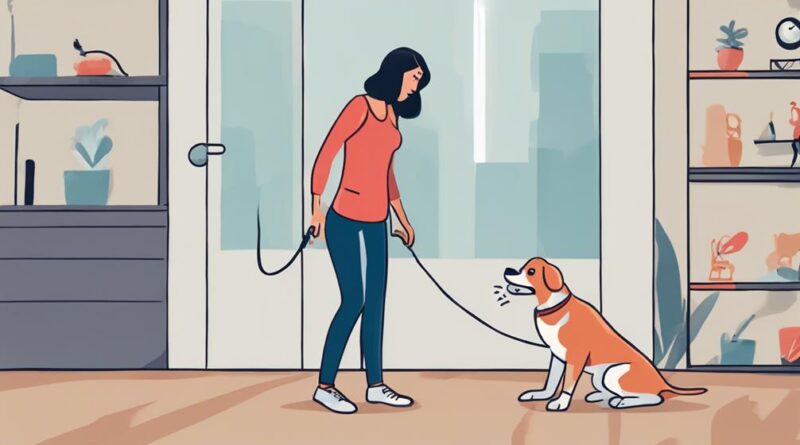Resolving Canine Behavioral Issues: Top Tips
Are you struggling with your furry friend's behavioral quirks?
From incessant barking to destructive chewing, navigating canine behavioral issues can be a challenge.
However, with the right approach and understanding, you can help your canine companion overcome these hurdles.
By incorporating some top tips and proven techniques, you can create a harmonious environment for both you and your beloved pet.
Understanding Canine Behavior Patterns
To better address your dog's behavioral issues, it's essential to understand the patterns in your canine's behavior. Observing your dog's body language is crucial in deciphering its emotions and intentions. Dogs communicate through their body posture, facial expressions, and tail movements. For example, a tucked tail and flattened ears may indicate fear or anxiety, while a relaxed body and wagging tail usually signal happiness.
Incorporating behavior modification techniques can help reshape your dog's unwanted behaviors. Positive reinforcement, such as rewarding good behavior with treats or praise, can be highly effective. Similarly, redirecting negative behaviors towards more acceptable ones through training exercises can bring about positive changes in your dog's conduct.
Implementing Positive Reinforcement Techniques
Using positive reinforcement techniques is an effective way to encourage desired behaviors in your canine companion. Reward-based training involves offering treats, praise, or toys to reinforce good behavior, making it more likely to be repeated in the future. When implementing behavior modification techniques, focus on rewarding positive actions rather than punishing unwanted behaviors. This approach helps your dog understand what behaviors are desirable, creating a stronger bond between you and your pet.
To start, identify specific behaviors you want to encourage and choose suitable rewards that motivate your dog. Consistency is key; always reward the desired behavior immediately to reinforce the connection between the action and the reward. Additionally, be patient and understanding during the training process. Remember that each dog is unique, so tailor your approach to suit your canine companion's personality and learning style.
Addressing Separation Anxiety in Dogs
When your dog exhibits signs of distress or destructive behavior when you're not around, it may be experiencing separation anxiety. Coping strategies and training methods can help alleviate this issue. To address separation anxiety, start by implementing preventive measures and considering environmental factors that may be contributing to your dog's anxiety.
One coping strategy is desensitization training, which involves gradually exposing your dog to being alone for short periods to help them become more comfortable with it. Another effective method is counterconditioning, where you can change your dog's negative association with being alone by providing them with a positive experience, like special treats or toys, when you leave.
Creating a safe and comfortable environment for your dog while you're away can also make a difference. Utilize interactive toys or leave clothing with your scent to provide comfort. Additionally, ensuring your dog gets enough exercise and mental stimulation can help reduce separation anxiety. By implementing these coping strategies and training methods, you can help your dog feel more secure and relaxed when you're not around.
Breaking Down Aggressive Behavior Triggers
Identify the specific triggers that provoke aggressive behavior in your canine companion to effectively address and manage their reactions. Dogs may exhibit aggression due to various triggers such as fear, territoriality, possessiveness, or frustration. Observing your dog's body language and reactions can help pinpoint what sets off their aggressive behavior. Once you have identified these triggers, you can implement behavior modification techniques to address them.
Behavior modification techniques involve desensitizing your dog to the triggers gradually, using positive reinforcement to encourage calm behavior, and providing alternative ways for your dog to cope with stressful situations. For example, if your dog shows aggression towards other dogs while on a leash, you can work on counter-conditioning by rewarding them for calm behavior around other dogs. Consistency and patience are key when using behavior modification techniques to address aggressive behavior triggers in your canine companion. By understanding and addressing these triggers, you can help your dog learn to react more positively in challenging situations.
Establishing Leadership Through Consistency
To establish leadership through consistency with your canine companion, maintain clear expectations and routines in your interactions. Consistency is key when it comes to training methods and behavior modification for your dog. Here are some essential tips to help you establish leadership effectively:
- Set Clear Rules: Clearly communicate what behaviors are acceptable and unacceptable.
- Use Positive Reinforcement: Reward good behavior to encourage its repetition.
- Stay Calm and Assertive: Dogs respond well to confident and calm leadership.
- Establish a Routine: Dogs thrive on predictability, so create a consistent daily schedule.
- Be Patient and Persistent: Behavior change takes time, so stay committed to the process.
Handling Fear and Phobias in Dogs
Establishing a sense of safety and trust is crucial in helping your canine companion overcome fear and phobias. When addressing fear and phobias in dogs, consider desensitization training and counterconditioning techniques. These methods involve gradually exposing your dog to the source of fear in a controlled manner while pairing it with positive experiences to change their emotional response. Building confidence is key; praise and reward your dog for small achievements during desensitization training to boost their self-assurance.
Incorporating desensitizing stimuli can help your dog become more comfortable with things that trigger fear. Start at a distance where your dog notices the stimulus but doesn't become overly fearful. Gradually decrease the distance over time as your dog shows signs of relaxation. Consistency is vital in this process; regular, short training sessions will yield better results than sporadic, long sessions.
Decoding Communication Signals in Canines

Understanding your dog's body language and vocalizations is crucial for interpreting their communication signals accurately. When decoding communication signals in canines, pay close attention to the following:
- Body Language Interpretation: Dogs use various body postures and movements to express their feelings and intentions.
- Canine Vocalizations: Different barks, whines, and growls convey different messages, such as excitement, fear, or warning signals.
- Pack Dynamics: Dogs are social animals with a hierarchical structure within a pack. Understanding this dynamic can help decipher their interactions.
- Social Cues: Dogs rely on social cues to communicate with each other and with humans. Recognizing these cues can enhance your understanding of your dog's behavior.
- Context Matters: Interpret your dog's signals in the context of their environment and past experiences to get a more accurate understanding of what they're trying to communicate.
Creating a Structured Routine for Dogs
Implementing a consistent daily schedule is key to fostering a sense of security and stability for your dog. By establishing set times for meals, walks, playtime, and rest, you provide a structured routine that helps your furry friend know what to expect each day. This predictability can reduce anxiety and behavioral issues in dogs. When creating a routine, it's crucial to enforce consistency. Stick to the same feeding schedule, walk times, and bedtime to help your dog feel secure and understand the boundaries you've set.
Incorporating training sessions into your daily schedule is also essential for establishing boundaries and reinforcing good behavior. Use consistent commands and positive reinforcement to guide your dog's actions and encourage obedience. Additionally, make time for mental stimulation activities like puzzle toys or training games to keep your pup engaged and mentally sharp.
Frequently Asked Questions
How Can I Determine if My Dog's Behavioral Issues Are a Result of a Medical Condition?
To find out if your dog's behavior is tied to a medical problem, observe any unusual changes like sudden aggression or lethargy. Schedule a vet visit to rule out underlying health issues causing the behavior.
Once medical causes are ruled out, focus on addressing behavioral concerns through training and positive reinforcement techniques. Remember, a proper diagnosis is key to effectively addressing your dog's behavior problems.
Are There Any Specific Breeds That Are More Prone to Certain Behavioral Issues?
Certain breeds do have tendencies towards specific behavioral issues. Understanding these breed traits can help tailor your training methods. Genetic factors play a role, but behavioral modification is possible through consistent training.
What Role Does Diet Play in Influencing a Dog's Behavior?
Nutrition impacts your dog's behavior more than you might think. Dietary changes can play a significant role in influencing how your furry friend acts.
A balanced diet with the right nutrients can promote good behavior and overall well-being in your canine companion. Make sure you're providing them with the proper nutrition to support their mental and physical health.
Your dog's diet can make a big difference in their behavior.
Can Hiring a Professional Dog Trainer Help With Resolving Behavioral Issues?
Hiring a professional dog trainer can greatly assist in resolving behavioral issues. With their expert training techniques and guidance, you can see significant behavioral improvements in your dog.
Behavior modification is often more successful when done under the supervision of a professional who understands canine behavior. Their experience and knowledge can help tailor a training plan that addresses specific issues and leads to positive changes in your dog's behavior.
How Important Is Exercise in Managing and Preventing Behavioral Problems in Dogs?
Regular exercise is crucial for managing and preventing behavioral problems in dogs. Physical activity not only helps maintain their overall health but also provides mental stimulation and enrichment.
Outdoor activities and socialization play a significant role in keeping your canine companion happy and well-adjusted. Make sure to incorporate exercise into your daily routine to promote positive behavior and a healthy lifestyle for your furry friend.
Conclusion
In conclusion, by understanding your dog's behavior patterns and implementing positive reinforcement techniques, you can effectively address common canine behavioral issues.
Remember to address separation anxiety, aggressive behavior triggers, and fear/phobias with patience and consistency.
Establishing leadership through a structured routine and decoding communication signals will help create a harmonious relationship between you and your furry friend.
With dedication and love, you can work through any behavioral challenges your dog may face.
